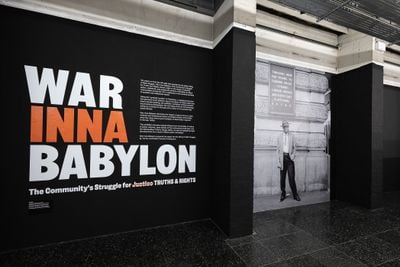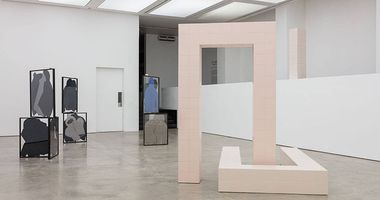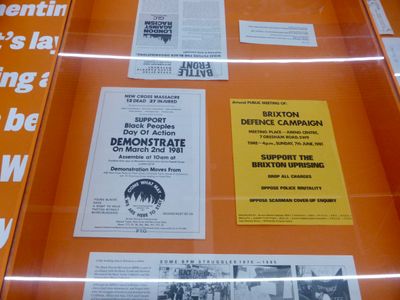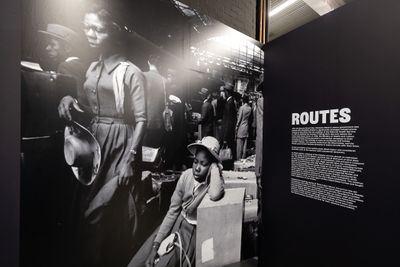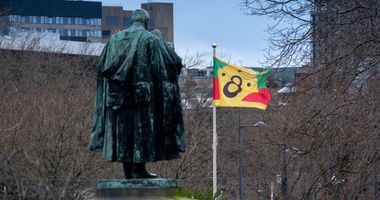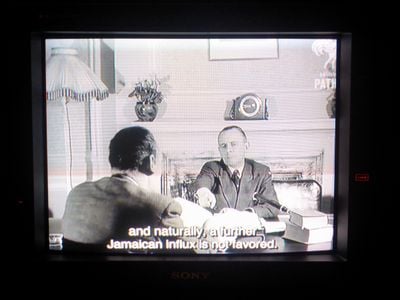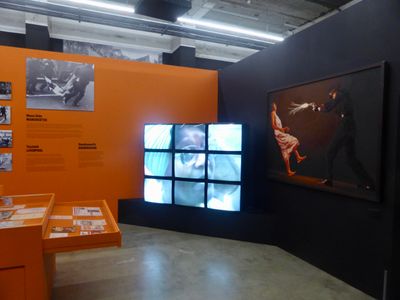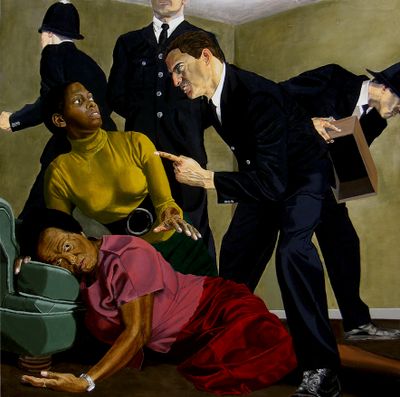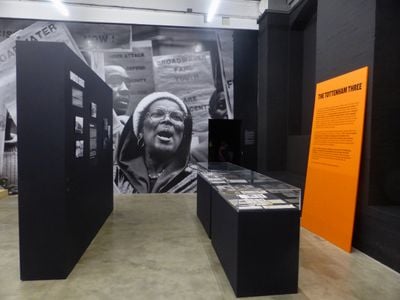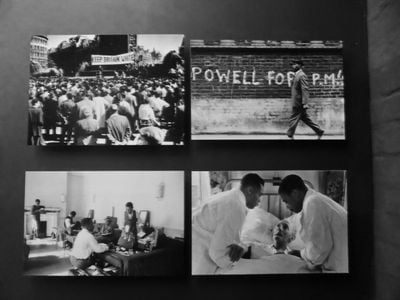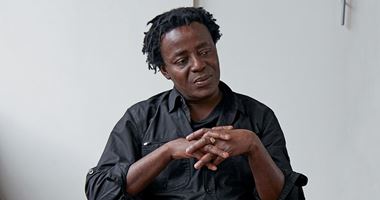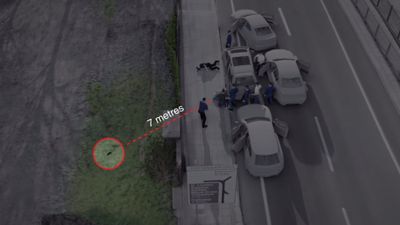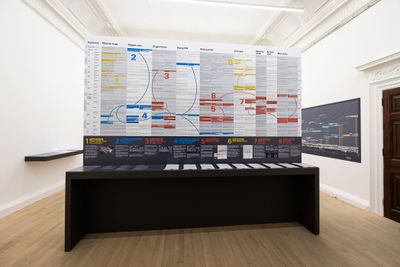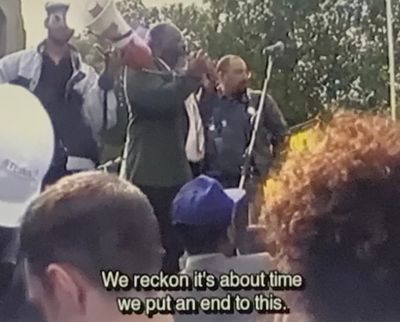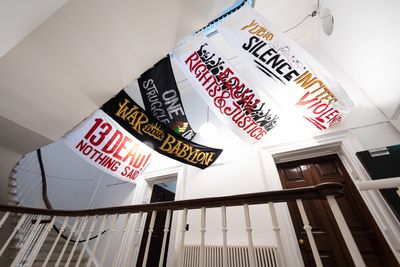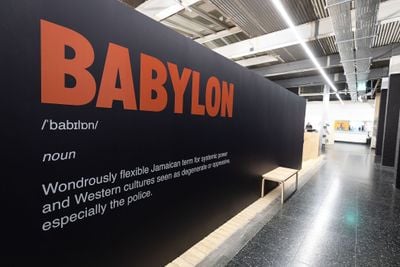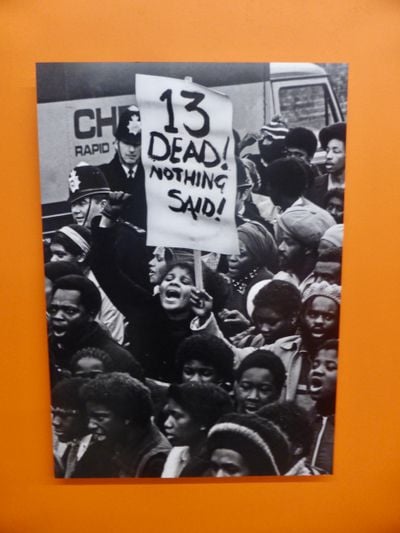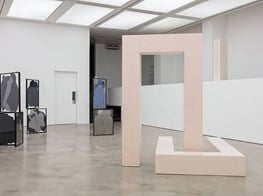ICA's War Inna Babylon is the Race Report the UK Needs
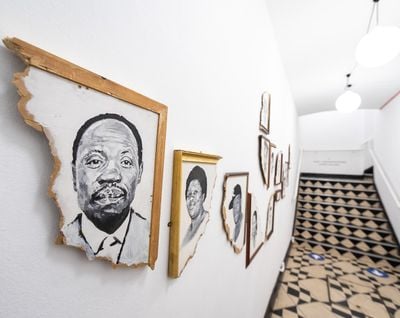
Paintings by Garnet Dore on view in War Inna Babylon: The Community's Struggle for Truths and Rights, Institute of Contemporary Arts, London (7 July–26 September 2021). Courtesy Institute of Contemporary Arts. Photo: Robert Croma.
'While War Inna Babylon was originally scheduled to open in May 2020, the delay due to Covid-19 has inadvertently made this the most timely exhibition it could possibly be.'
So said Stafford Scott, co-founder of Tottenham Rights, which have organised, with independent curators Kamara Scott and Rianna Jade Parker, an unflinching exhibition about anti-Black racism that opened at London's Institute of Contemporary Arts (ICA, 7 July–26 September 2021) on the heels of the Commission on Race and Ethnic Disparities report.
Released in March 2021, the dossier denied the existence of institutional racism in the U.K., and the fall-out was immediate. Those involved claimed findings were twisted, while Downing Street's most senior advisor on ethnic minorities Samuel Kasumu, who set up the group, resigned.1
Writes Aditya Chakrabortty, studies were taken out of context. On police stop and search, one is quoted as 'suggesting that drug crime patterns change when stop and search is taking place in an area', only for Chakrabortty to find it actually says claims of stop and search being 'an effective way to control and deter offending seem misplaced.'2
A section of the exhibition, elegantly designed by Abi Wright, looks at the stop-and-search sus ('suspected person') law, which Gloucestershire County Council, a government entity, states was strategically used against Black men from the 1960s.3
These men were often of the Windrush generation—people from the West Indies who, on the U.K. government's invitation, came to legally settle here and work in the NHS and other sectors affected by post-war labour shortages—or their children.
The Windrush generation, later subjected to wrongful detentions, deportations, and denial of legal rights because the Home Office insidiously destroyed landing cards and other records, takes its name from the ship that arrived in June 1948.
One month later, the white community instigated a race riot in Liverpool—home to the country's oldest Black population, a legacy rooted in the port's central role in the slave trade—whose racism the 1989 Gifford Report called 'uniquely horrific'.4
With anti-Black attitudes encapsulated in public broadcasting like British Pathé's 1955 short 'Our Jamaican Problem', screened in the ICA display, things intensified through to 1981, when waves of anti-racist uprisings and demonstrations unfolded across England.
In Brixton, these were sparked by the sus-fuelled 'Operation Swamp': infused with Margaret Thatcher's dog-whistle description of the country being 'swamped by people of a different culture', and police commissioner Kenneth Newman's view of Jamaicans as 'constitutionally disposed' to disorder.
The 1982 Scarman Report blamed social deprivation and intense policing for the 1981 insurrections. A copy is found in an archival drawer located in a room honouring community efforts—involving the Black People's Organisation Campaign Against Sus, The Black Parents Movement, and Runnymede Trust—that contributed to the sus repeal.
Still, the 1984 Police and Criminal Evidence Act picked up where sus left off. A law demonstrating a convenient elasticity—per the U.K. government, 'police can stop and question you at any time'5—in the judicial system, where 'justice' tends to lean to the state. (Hence this exhibition's subtitle, The Community's Struggle For Justice Truths and Rights striking the word through.)
The problem with justice is reflected in the case of five Tottenham families that have experienced bereavement as a result of excessive police force, whose testimonies play on five tall pillars in the Upper Gallery.
In one video, Myrna Simpson, part of the Windrush Generation, remembers her first-born. Joy Gardner was violently bound, gagged, and suffocated in 1993—in front of her five-year-old son—for the 'crime' of outstaying her visa, despite seeking legal routes to remain and warning letters 'deliberately' delayed.6
In another video, Cynthia Jarrett, who died from a heart attack in 1985 after police stormed her home without a warrant, is fondly described as full of life by her son.
Jarrett is commemorated in Kimathi Donkor's 2005 painting Madonna Metropolitan: the Death of Cynthia Jarrett, with another, Under Fire: The Shooting of Cherry Groce, referencing the shooting of an innocent Black mother during a home raid in 1985, leaving her wheelchair bound.
After Jarrett's death, protests erupted at Broadwater Farm Estate, whose Youth Association was visited by Princess Diana in February that year to recognise the work being done by a community contending with the failure of the U.K.'s social housing projects.
Scott's eyewitness account of the protest, supported by Black Labour politician Bernie Grant, recalls police chanting 'this is not Brixton'—a reference to protests prompted by Groce's shooting one week prior.7
A vitrine shows documentation of the campaign to overturn the 1987 convictions of three men baselessly accused of a policeman's death during the insurrection, which was achieved in 1991. Chief prosecutor Roy Amlot said he would never have taken on the case had he known 'of the apparent dishonesty of the officer in charge.'8 (Amlot later became a human rights lawyer.)
A blown-up photograph emblazoning one wall captures a rally supporting the accused.
The woman holding a sign reading 'Broadwater Farm Youth Are Innocent!' is Scott's mother, once fully invested in the Windrush promise, whom Scott says was the first person he and his brothers educated on the daily racism they endured. Whether walking past 'Keep Britain White' rallies or graffiti advocating for racist ultranationalist Enoch Powell, per archive images on display.9
Scott appears in Menelik Shabazz's 1985 documentary The People's Account, screening in the ICA's Ceddo Film Room—commissioned by Channel 4 but mothballed for 30 years—to put 1985 in context, when unrest in London and Birmingham was sparked by disproportionate police violence against Black women.
The documents on display constitute a practice that is creative out of necessity: a sustained challenge to the monopoly on truth and representation that has been shown to obscure injustice in plain sight.
Black Audio Film Collective's Handsworth Songs (1986), not included in the show, tracks the Birmingham events, with one woman stating: 'There are no stories in the riots, only the ghosts of other stories.'
Those ghosts are the histories of chronic injustice and disenfranchisement that likewise haunted the riots sparked by the fatal 2011 police shooting of Mark Duggan, including the conservative government's austerity campaign that fuelled high unemployment levels and cuts to youth services. (James Jones' documentary The Riots, streaming on BBC iPlayer, offers a revealing account of that summer.)
A video by Forensic Architecture, The Investigation of the Killing of Mark Duggan (2019) is on view in the final gallery: a commission by the Duggan family's lawyers to create 'a navigable digital environment [...] to illustrate and interrogate the testimonies involved in the shooting.'
What emerges are contradictions with the 'lawful killing' verdict given to the officer who claimed he shot Duggan because he saw a gun in his hands, though a 2014 inquest concluded 'Duggan did not have a weapon in his hands when confronted by police and had thrown it from the cab'.10 (The gun was found seven metres from the scene.)
Forensic Architecture's meticulous reconstruction has not prompted the case's reopening, leaving Duggan's family to contend with questions unanswered. A tragedy shared by others and memorialised in Garnet Dore's black and white portraits of lost lives lining one corridor, framed like torn fragments.
A damning example of state-sponsored discrimination concludes War Inna Babylon. A display about the Gangs Matrix echoes the media and political narrative that seemed to frame all Black youth as mobsters, fuelled by the violence of summer 2011, thus overshadowing the systemic conditions that fuelled events. (In the show, a display of TV monitors tracks media and political responses at the time.)
The system, implemented in 2011 by then-London mayor Boris Johnson, compiles lists disproportionately labelling Black people as gangsters, with state services withdrawn from them and their families as a result.
Tottenham Rights counted 80 percent Black names out of 3000 in the Matrix. On view is a sample list from Haringey. Despite the Tottenham Turks allegedly constituting the area's largest gang, Scott identifies 99 Black names out of 100, most without a criminal record.11
Amnesty International found the Matrix, guilt by association, to contravene data protection laws, equality legislation, and the Met's rules of conduct, with the ICO ruling the police intended harm. As Scott says, systemic discrimination pushes youth to crime. On his own sus experiences, he says he 'became that guy because they treated me like that guy.'12
There's a drawing of Martin Luther King in the show, 1st Class Citizenship, which Scott made while imprisoned under sus in 1979. It quotes King's famous dream: that 'children will one day live in a nation where they will not be judged by the colour of their skin but by the content of their character.'
Back then, Scott writes, when his generation would invoke the decolonial mantra of self-determination—that is, 'self-defence is no offence'—the goal remained hopeful.
With King's quote in mind, it was striking to read a dismissal of the exhibition in The Critic.
Especially in light of the Prime Minister and Home Secretary's public dismissal of the England football team's taking the knee in a gesture of anti-racist solidarity, which legitimised the abhorrent, racist abuse openly levelled at young Black football players after the UEFA Euro 2020 championship final.
Without seeing the show the man complained of its 'artivism', and dragged the 2021 Turner Prize nomination for collectives in a tone echoed by art critics who did not engage with the practices they dismissed before slamming them. (All while demonstrating an ability to recognise, in another piece looking at Nazi-looted art, how 'past events' of injustice can 'cast shadows'.)
Is that not an example of privilege? To make judgments—to slap on labels—without looking at the context and casting evidence aside? Is art not a practice predicated on material representation?
Ultimately, War Inna Babylon shows how one community has found ways to correct generations of trauma themselves. Of having to justify their rights so blithely dismissed by those who conveniently 'forget' how Britain's multicultural society was made. (Or any other settler colonial state.)
The documents on display, much of which comes from Scott's archive, constitute a practice that is creative out of necessity: a sustained challenge to the monopoly on truth and representation that has been shown to obscure injustice in plain sight.
To quote Scott, who gives generous, illuminating, and highly recommended exhibition tours on Thursdays (officially from 7pm) and Saturdays (informally from 5pm), with free entry on Tuesday (plus a public programme worth following): 'We can't leave families on their own to take on the weight of the state.'
With that, War Inna Babylon is not only the race report the U.K needs right now. It is a call to action. —[O]
1 'Samuel Kasumu: PM's adviser quits amid row over race report', BBC, 1 April 2021, Accessed 17 August 2021, https://www.bbc.co.uk/news/uk-politics-56601166
2 Aditya Chakrabortty, 'The UK government's race report is so shoddy, it falls to pieces under scrutiny', The Guardian, 16 April 2021, Accessed 17 August 2021, https://www.theguardian.com/commentisfree/2021/apr/16/government-race-report-evidence; 'Samuel Kasumu: PM's adviser quits amid row over race report', BBC, 1 April 2021, Accessed 17 August 2021, https://www.bbc.co.uk/news/uk-politics-56601166
3 'Race Relations Acts 1965 – 2000', Gloucestershire County Council, Accessed 17 August 2021, https://www.gloucestershire.gov.uk/your-community/black-history-month-2020/race-relations-acts-1965-2000/sus-laws/
4 'Race discrimination in Liverpool widespread, finds study', The University of Manchester, News, 7 June 2012, Accessed 17 August 2021, https://www.manchester.ac.uk/discover/news/article/?id=8355
5 'Police powers to stop and search: your rights', Gov.UK, Accessed 17 August 2021, https://www.gov.uk/police-powers-to-stop-and-search-your-rights
6 'Death in Policy Custody of Joy Gardner', Amnesty International, August 1995, Accessed 17 August 2021, https://www.amnesty.org/download/Documents/172000/eur450051995en.pdf
7 As told to visitors during Scott's tour of the show on Saturday, 14 August.
8 Stafford Scott, 'End this Blakelock obsession', The Guardian, 7 December 2003, Accessed 17 August 2021, https://www.theguardian.com/society/2003/dec/07/raceintheuk.comment
9 As told by Scott during a tour of the show on Saturday, 14 August 2021.
10 Haroon Siddique, 'Mark Duggan police shooting: can forensic tech cast doubt on official report?', The Guardian, 10 June 2020, Accessed 17 August 2021, https://www.theguardian.com/uk-news/ng-interactive/2020/jun/10/mark-duggan-shooting-can-forensic-tech-cast-doubt-on-official-report
11 As told during Scott's tour of the show on Saturday, 14 August 2021.
12 Ibid.

